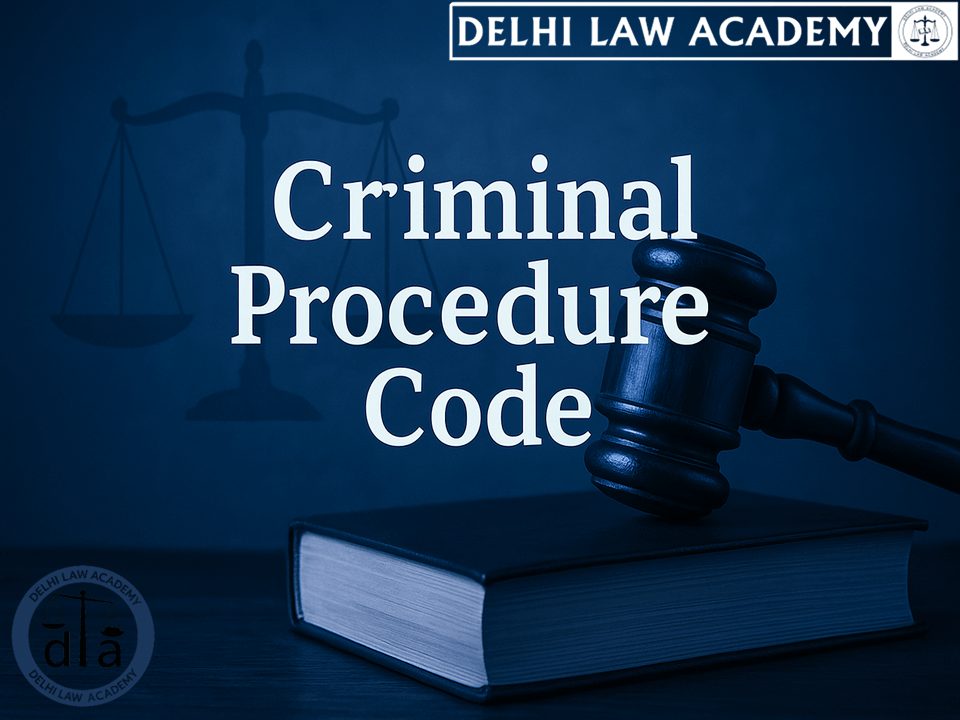
⚖️ Criminal Procedure Code: Bail in Non-Bailable Offences (Continued)
📘 Supreme Court in Gurcharan Singh v. State (Delhi Admn.) [1978]
Continued from the previous post…
- The two paramount considerations: likelihood of the accused fleeing from justice and his tampering with prosecution evidence, relate to ensuring a fair trial of the case in a Court of Justice.
🎓 Preparation for RJS, DJS, PCS (J) and Other Judicial Service Exams
The Criminal Procedure Code forms the bedrock of every Judicial Service exam in India. Its thorough knowledge is a must for aspirants of RJS, DJS, PCS (J) and other Judicial Service exams. To help such aspirants, DELHI LAW ACADEMY JAIPUR has launched a series of study modules covering key syllabus topics.
📚 Provisions of Bail and Bond (Section 437 – Continued)
Section 437(2): Not Non-Bailable
- If it appears to such officer or Court at any stage that there are no reasonable grounds for believing that accused has committed a non-bailable offence, but there are sufficient grounds for further inquiry into his guilt, accused shall be released on bail or on execution by him of a bond without sureties.
Note: This again shows that bail is a bond with sureties.
Section 437(3)
- When a person accused or suspected of an offence punishable with imprisonment of seven years or more or under Chapters VI, XVI or XVII of IPC is released on bail, Court shall impose these conditions:
Mandatory conditions:
- (a) Such person shall attend in accordance with conditions of the bond.
- (b) Such person shall not commit an offence similar to the offence of which he is accused or suspected.
- (c) Such person shall not make any inducement, threat or promise to any person acquainted with facts of the case so as to dissuade him from disclosing such facts to a court or to a police officer or tamper with evidence.
Other conditions: Court may also impose such other conditions as it considers necessary in the interest of justice.
Section 437(4)
- An officer or Court releasing any person on bail under sub-section (1) or (2) shall record in writing reasons or special reasons for so doing.
Section 437(5)
- Any Court which has released a person on bail may direct that such person be arrested and commit him to custody if it considers it necessary so to do.
Section 437(6)
- In a case triable by Magistrate: If trial in case of a non-bailable offence is not concluded in sixty days from the first date fixed for taking evidence, accused shall be released on bail unless the Magistrate otherwise directs for reasons to be recorded in writing.
Section 437(7)
- If at any time after conclusion of trial but before judgment Court has reasonable grounds for believing that the accused is not guilty, it shall release him on execution by him of a bond without sureties for his appearance to hear the judgment.
Section 437A [w.e.f. 31-12-2009]
- Before conclusion of trial: court trying the offence shall require the accused to execute bail bonds with sureties to appear before the higher court when such court issues notice on an appeal.
- Such bail bonds shall be in force for 6 months.
- Before disposal of appeal: Appellate court shall require the accused to execute bail bonds with sureties to appear before the higher court when such court issues notice on an appeal or petition against judgment.
- Such bail bonds shall be in force for 6 months.
The unwritten code:
- Once an accused always an accused
- Once in bond always in bond
- Once arrested always in bond
⚖️ Gurcharan Singh v. State (Delhi Admn.) [1978 SC]
Continued from the previous post…
- At that stage, unless the Magistrate is able to act under the proviso to Section 437(1), bail appears to be out of question. The only limited inquiry may then relate to the material for the suspicion. The position will naturally change as investigation progresses and more facts and circumstances come to light.
- The over-riding considerations in granting bail which are common both in case of Section 437(1) and Section 439(1) are:
- Nature and gravity of the circumstances in which the offence is committed
- Position and status of the accused with reference to the victim and witnesses
- Likelihood of the accused fleeing from justice; of repeating the offence; of jeopardising his own life being faced with a grim prospect of possible conviction; of tampering with witnesses
- History of the case as well as of its investigation
- Other relevant grounds which, in view of so many valuable factors, cannot be exhaustively set out
- We may repeat the two paramount considerations, viz. likelihood of the accused fleeing from justice and his tampering with prosecution evidence, relate to ensuring a fair trial of the case in a Court of Justice. It is essential that due and proper weight should be bestowed on these two factors apart from others.
Facts of the case and application of law:
- Appellants ranging from DIG of Police and Superintendent of Police at the top down to some police constables were a party to a criminal conspiracy to kill Sunder and caused his death by drowning him in the Yamuna in pursuance of the conspiracy.
- According to prosecution, the murder took place on the night of November 24, 1976. Appellants were arrested between June 10, 1977 and July 12, 1977. The Magistrate declined to release them on bail. Thereafter, they approached the Sessions Judge u/s 439(1) and secured release on bail in August 1977.
- The Delhi Administration moved the High Court u/s 439(2) for cancellation of bail. On September 19, 1977, the High Court set aside orders of the Sessions Judge.
- Delhi Administration moved the High Court for cancellation of bail alleging that there was grave apprehension of the witnesses being tampered with by the accused on account of their position and influence which they wielded over the witnesses.
- The witnesses stated on oath u/s 164 that they had made the earlier statements due to pressurisation by some of the appellants. Where the truth lies will be determined at the trial.
- The only question which the Sessions Judge was required to consider at that stage was whether there was a prima facie case made out, as alleged, on the statements of the witnesses and on other materials.
- We are satisfied that the High Court has correctly appreciated the entire position.
🔹 Delhi Law Academy Jaipur — Comprehensive CrPC Notes for RJS | DJS | PCS(J)
💬 FAQs — Bail in Non-Bailable Offences (CrPC §437 Continued)
- The accused must attend in accordance with the bond.
- He must not commit a similar offence while on bail.
- He must not make any inducement, threat, or promise to witnesses, or tamper with evidence.
These are designed to protect the trial process while allowing bail.
- Sub-sections (1) to (7) and Section 437A with examples.
- Conditions for bail, cancellation, and exceptions.
- The Supreme Court’s reasoning in Gurcharan Singh on judicial discretion and fairness.
- The contrast between “reasonable grounds for believing guilty” vs. “reasonable grounds for believing not guilty.”
Understanding both statute and case law ensures strong CrPC answers.
🔹 Delhi Law Academy Jaipur — CrPC Section 437 Detailed Notes | RJS | DJS | PCS(J)
📘 Free Study Material for Judiciary Aspirants!
Download our FREE study material prepared by Delhi Law Academy’s expert faculty.
Contact us
📍 Delhi Law Academy – Jaipur Branch
6C, Tower 2, Coaching Hub, Pratap Nagar, Jaipur – 302033
📞 Phone:
+91 9911916552
+91 8447285606
✉️ Email:
contactus@delhilawacademy.com

